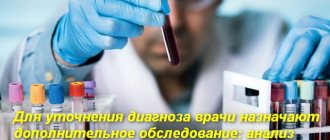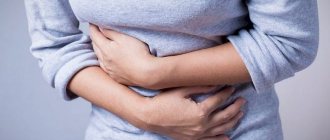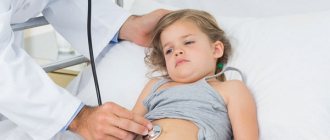Rotavirus infection is an acute disease that affects the intestines and disables other body systems.
Children most often suffer from intestinal flu, but adults are not immune from it either, since the disease is incredibly resistant to high and low temperatures, as well as to most disinfectants.
Most often, rotavirus affects people with a weakened immune system. The causes of the virus are quite banal. Most often, the disease appears as a result of non-compliance with standard hygiene measures and food hygiene. Very often, unwashed vegetables and fruits, as well as dirty hands, lead to the appearance of intestinal flu.
Detecting and diagnosing rotavirus is quite simple, since this disease has a number of specific symptoms, namely:
- Vomit;
- Diarrhea;
- Heat;
- Abdominal pain;
- Weakness.
Additionally, rotavirus is characterized by severe fever and dehydration. The body temperature is kept within 38 degrees and does not drop for several days.
However, intestinal flu does not always occur in the same way. In some cases, the disease may manifest itself latently. Gradually, over time, the virus increases its pathogenic influence. The gastrointestinal tract is most affected by rotavirus.
To make a more accurate diagnosis and prescribe adequate treatment, it is necessary to undergo a full diagnostic study, which includes not only a clinical examination, but also laboratory tests. It is the tests that help to obtain complete and general information about the existing disease.
It must be remembered that focusing on self-medication may not provide the expected results. The symptoms of rotavirus infection are extremely similar to many other pathogenic conditions, such as poisoning.
About the disease
The incubation period of intestinal infection lasts 2 days, then symptoms of the disease appear:
- a person suffers from abdominal pain;
- repeated vomiting and nausea appear;
- dark shade of urine;
- diarrhea, loose stools with a peculiar sour aroma;
- pale skin is noted;
- temperature rises;
- weakness, malaise;
- redness of the eyes;
- blood in stool;
- Your throat may hurt and you may have a runny nose.
Symptoms last no more than 5-7 days, then with timely treatment recovery occurs. Often, after rotavirus, the patient develops immunity, and secondary infection does not occur. In an adult, the disease is easier. There is a decrease in appetite, a slight increase in body temperature, and sometimes diarrhea. A person becomes a carrier of the virus and is easily able to infect others.
Signs of an infectious disease can easily be confused with poisoning, salmonellosis, and other pathologies. To determine the diagnosis, the doctor will send you to take tests for rotavirus.
The cause is direct contact with an infected person, as well as the use of various objects and things previously used by the patient. Reproduction is observed in the mucous membrane of the gastrointestinal tract, after which it is excreted along with feces. If the mucous membrane is disrupted, the process of digestion of food is disrupted, and this leads to diarrhea and dehydration.
Treatment scenario
If you have intestinal flu, monitor your child's feeding. Eliminate dairy. Lactic bacteria will help the virus take over the drugs. Refrain from normal food until the illness disappears.
Make your child drink clean boiled water without sugar or gas. Choose liquid and lean products. A good solution is broth, rice porridge with water. Blend the porridge in a blender. The diet is strict, a new product is added after the doctor’s permission.
Children do not like this food - explain the benefits and feed the child before taking the pills. Regularly taking medications on an empty stomach will damage the liver and stomach.
For abdominal pain, no-shpa made from natural ingredients is recommended. Relieves spasms, pain, has an anti-inflammatory effect. Buy the drug in drops - it’s easier for your child to take.
A gag reflex and diarrhea are dangerous symptoms of the disease. Dehydration, malaise, and death occur. They need to be docked. Doctors recommend using Smecta.
Doctors are engaged in destroying the virus in the intestines, mothers are taking care of restorative therapy. The doctor will recommend medications.
Symptoms of the child’s recovery are disappearance of temperature, good sleep. When you wake up, give your baby water or rosehip decoction.
Diagnostics
Laboratory tests for rotavirus infection can accurately identify virus microbes. The general information obtained from the study will help guide appropriate treatment. They help prescribe appropriate medications that can eliminate the most dangerous symptoms of the pathology.
The use of laboratory tests allows you to correctly study a person’s condition and find out whether there is any other threat.
To prevent the spread of rotavirus infection in children and adults, the patient is prescribed the following tests:
- blood, urine;
- stool due to rotavirus infection;
- electron microscopy;
- use of rapid tests;
- method of examining the rectum;
- PCR analysis.
Basically, such analyzes are carried out in combination. But sometimes the gastroenterologist orders 1-2 tests from this list.
Blood
The most common manipulation is a blood test; it allows you to determine which bacteria have settled in the body. After all, rotavirus values of leukocytosis are easily replaced by leukopenia. Monocytosis and lymphocytosis are also possible.
An auxiliary measure is the analysis of RSC, RTGA. Such procedures make it possible to detect the virus in the patient’s blood by detecting antibodies, which are used to combat the pathology.
But such measures are not always accurate, since protective antibodies arise very late.
Feces
Laboratory analysis of stool for rotavirus becomes the final stage, that is, it is performed at the last moment, because traces of the virus are formed only on the 3rd day of infection.
To collect stool you will need to follow some rules:
- do not take any medications (rectal suppositories, laxatives), they will change the composition of stool, including their indicators;
- It is forbidden to perform an enema a day before the test, this will also affect the results;
- stool for rotavirus should be placed in a clean container purchased at a pharmacy. The material must be submitted no later than 3 hours after bowel movement, so it is advisable to put it in the refrigerator before the laboratory;
- write your name and date on the container;
- 24 hours before collecting excrement you should not take alcoholic drinks, spicy or fatty foods.
With rotavirus, the structure of the stool changes. The shade becomes lighter, and the density becomes uneven. Drops of blood and mucus may be observed in the stool. Transcripts of test results can be found the day after the test. In accordance with the data received, the doctor prescribes treatment.
Urine
Urine examination allows you to recognize proteins, leukocytes, and red blood cells. The values will indicate deviations or normality.
During an intestinal infection, urine changes from a light yellow tone to a darker one, this indicates the presence of pathogenic microorganisms. No specific preparation is required for the procedure.
You need to purchase a container at the pharmacy, collect the urine and try to immediately deliver it (within a couple of hours) to the laboratory. The sooner the material arrives, the more accurate the indicators will be.
It is advisable not to drink alcohol or cigarettes several hours before collecting the analysis. It is better to carry out the manipulation on an empty stomach, that is, collect urine in the morning.
Express test
This type of diagnosis involves research carried out at home. This method of detecting rotavirus is quite effective, but therapy should still be carried out as prescribed by a specialist.
The rapid test is carried out using a special device purchased from a pharmacy. It is called the Rota test or something a little different.
To perform it correctly, you need to read the attached instructions. Stool is taken and placed in the location indicated on the test. If the stool is mixed with urine, the test cannot be performed.
After 15 minutes, the result will be visible on the device. If there are 2 stripes, the pathogen is present in the body. It is prohibited to use the device twice.
Differential diagnosis
In difficult situations, special diagnostic methods are used to make an accurate diagnosis. The differential method is performed through laboratory, clinical tests, and epidemiological history.
Since rotavirus disease has a different etiology, you will need results that there really is a virus in the body, namely a stool test for rotavirus infection and blood. At the time of examination, it is important to exclude the existence of cholera, food poisoning, salmonellosis, and other factors that form during the activity of pathogenic microbes.
Diagnosis is very difficult if clinical signs are not clearly defined:
- for example, salmonella does not change the mucous membrane of the throat, but other symptoms are very similar. For bacteriological analysis, it is necessary to donate blood, stool, and study vomit;
- rotavirus is often similar to cholera, but the virus is milder. Cholera is helped to distinguish between Vibrio cholerae and NAG infections;
- But with dysentery everything is much more complicated. The disease is characterized by intense abdominal pain, and the stool is muco-bloody. The main emphasis for identifying the disease is on bacteriological examination.
At the time of such diagnosis, it is important to correctly study the results of all tests. An auxiliary action is to conduct an analysis for bacteria and parasites.
Medical indications
The virus is contagious and goes away on its own within 3-9 days. It is dangerous for patients who have undergone a bone marrow transplant (taking immunosuppressants). If a child becomes ill with rotavirus infection, it is recommended to replenish lost water throughout the illness. Correct and timely treatment of the disease eliminates the development of serious complications. The virus stays in the patient’s body for 7-10 days.
The following symptoms are characteristic of rotavirus infection:
- drowsiness;
- lethargy;
- poor sleep;
- long crying without tears;
- flabby skin;
- severe and prolonged diarrhea (5-7 days);
- vomit;
- heat;
- stomach ache.
If there is blood in the stool of an infected child, this means that the disease is severe. If the above symptoms are detected, a stool test for rotavirus is prescribed. Symptoms of the disease in question in adults include nausea, refusal to eat, abdominal pain, and loose stools. In older children and adults, the disease develops without vomiting or high fever.
The virus is not characterized by a cough or rash, so if they occur, it is recommended to immediately seek help from a doctor. Similar symptoms are characteristic of measles. Diarrhea with the infection in question can be mild, severe, or long-lasting. Abdominal cramps stop after bowel movement. Vomiting and diarrhea dehydrate the body, which is dangerous for newborn babies.
The maximum amount of infection in the stool is observed 3-5 days after the appearance of the initial symptoms of the disease. Then the concentration decreases, rotavirus is eliminated from the body 3-4 days after the end of the acute phase. Testing for rotavirus is scheduled up to 8 days after infection. Otherwise, an insufficient amount of infection in the stool will give a negative result.
Forecast
Young children are difficult to tolerate rotavirus infection. At the initial signs of pathology, you should urgently call an ambulance. To prevent dehydration, you must constantly drink fluids. The doctor will examine the baby and, if necessary, send him to the infectious diseases department or prescribe certain treatment methods and medications - this is Regidron, sorbent drugs, antipyretics.
To prevent the development of infection, doctors recommend that your child be vaccinated against rotavirus. Almost all children tolerate it well. Very rarely, an allergic reaction, increased nervousness, vomiting, and mild diarrhea are possible for a week after vaccination.
gastrot.ru
When should diagnostics be carried out?
Susceptibility to infection is very high; after an illness, unstable immunity is formed and does not provide complete protection against other viruses of various groups. A viral infection is transmitted from a sick person to a healthy person through the fecal-oral route.
In addition, other methods of infection are possible: contact and household (through common objects), water (through dirty water intended for drinking), nutritional (food). The clinical picture of intestinal infection is similar to many gastrointestinal diseases. How to determine the presence of rotavirus?
If you experience the following symptoms, you should contact an infectious disease specialist as soon as possible:
- nausea and repeated vomiting;
- increased body temperature;
- soreness and rumbling in the abdomen;
- upset stool (diarrhea);
- pale skin;
- dry skin and mucous membranes (a symptom of dehydration);
- muscle weakness, headache, lethargy;
- Sometimes symptoms of ARVI may be present (runny nose, sore throat, loss of strength).
What is rotavirus
It is one of numerous viral agents that can only cause disease in humans. Accordingly, the source of infection is only a person with obvious clinical symptoms or a practically healthy carrier. Rotavirus gets its name from the Latin word for “wheel,” since it is this object that resembles a microbial particle under electron microscopy.
A feature of rotavirus is its resistance to environmental factors. It tolerates the effects of high and low temperatures, treatment with disinfectants, and ultraviolet radiation quite well. This microbial agent is well preserved inside biological fluids of the human body (such as stool, vomit, secretions from mucous membranes), as well as on food products (at refrigerator temperature), on the surface of household items (toys, dishes).
Types of research
If the first signs of the disease appear, you should urgently consult a specialist. He will give you directions in which to get tested for an intestinal infection.
The result can be obtained the very next day after the material is submitted to the laboratory. Diagnosis of rotavirus infection includes the study of biological material: feces, urine, saliva and vomit.
Fecal analysis
Stool analysis for rotavirus infection is the main type of test for diagnosis. The main rule for collecting material is no contact with the toilet, potty or diaper of the child; feces are not allowed after using an enema or after inserting rectal suppositories. If these rules are not followed, the results may be greatly distorted.
Place at least 3–5 grams of feces in a clean container and close it tightly with a lid. It is permissible to store the container in a cool place for no more than 12 hours. If VP6 rotavirus antigens were found, which belong to group A, then the result will be positive and the doctor will diagnose rotavirus infection.
If they are absent, it is negative. For accurate diagnosis, the PCR or ELISA method is used. If the result is questionable or false-positive, the patient must take a stool test again.
Blood analysis
If rotavirus is present in the body, then the blood changes somewhat: there is an increase in leukocytes, which is quickly replaced by a decrease in lymphocytes and monocytes. ESR is usually within normal limits, although there are exceptions.
After receiving the data, you need to consult with a specialist. The blood sampling procedure is performed by a medical professional under sterile conditions using aseptic rules.
Analysis of urine
When examining urine, you can observe an increase in leukocytes in it, the appearance of red blood cells, protein and even cylinders. The main rule for collecting material is proper hygiene of the genital tract before the procedure, as well as a clean, sterile container with a tight screw-on lid.
Evaluation of test results
You can evaluate the test results 15 minutes after the procedure. If there is no rotavirus, a green stripe will appear in sector C. Other possible results:
- red and green stripes in sector T – rotavirus confirmed;
- green and blue stripe – adenovirus;
- green, blue and red stripes – rotavirus-adenovirus;
- absence of a green stripe - the analysis was carried out incorrectly and the test should be repeated.
The test can only determine a tentative result. Doctors usually do not prefer this diagnostic method. To confirm or refute the presence of rotavirus, you should visit a medical facility and undergo a comprehensive diagnosis.
kishechnik.guru
Methods for examining stool for intestinal infection
The main task of laboratory technicians is to identify a particular pathogen in a biological fluid. To find the causative agent of intestinal infection, doctors use several methods:
- Latex agglutination reaction (RAL). The reaction consists of an antigen-antibody reaction. For this purpose, a special antigen is selected that is sensitive to red blood cells and latex particles. When they interact, a complex is formed, which precipitates and indicates the presence of an intestinal infection.
- Enzyme-linked immunosorbent assay (ELISA). The principle is the binding of immune cells to antigens of pathogens. Using a special enzyme, the resulting complex is determined.
- Polymerase chain reaction (PCR) involves repeated copying of DNA and RNA fragments using special enzymes. After treatment, the doctor compares the results with the base and identifies the pathogen.
- Immunoelectron microscopy (IEM) makes it possible to determine a pathogen that multiplies in cell culture, and there are no other test systems for it. The method is based on the interaction of antibodies with viruses when mixing materials containing these viruses with a special serum.
To detect the presence of rotavirus at home, you can use Pharmasco CITO TEST ROTA. These are test cassettes that help diagnose the presence of infection within a few minutes. But it is worth noting that the tester can also show a false result. You can buy it at a pharmacy without a specialist prescription and test it at home according to the instructions.
What symptoms does it present?
The following pronounced symptoms are considered to be the reason for testing for this type of infectious disease:
- in the first few days, the body temperature rises to 38.5 – 40 degrees;
- in the upper part of the eligastrium there is pain;
- gag reflexes are observed four or more times during the day. This happens even in the morning, on an empty stomach;
- appetite decreases sharply;
- There is general weakness in the body.
After some time, acute diarrhea begins. The fecal matter has a watery consistency, the color is yellow, the smell is sour. Mucus and blood particles may be detected in the stool. Severe diarrhea is a medical emergency because it may cause dehydration, accompanied by cramping and confusion.
As a rule, with the symptoms of poisoning, signs characteristic of an acute respiratory disease are revealed:
- rhinitis;
- pain in the throat;
- swelling of the throat;
- redness of the ocular mucosa.
By the time of recovery, the body produces special antibodies that can resist rotavirus, and further effects of the lategen on organs are not so acute.
For those who were ill in childhood, re-infection is marked by low-grade fever and loose stools observed once or twice a day. The child's condition is relieved, but there are obstacles to identifying pathological abnormalities. In this case, the examination is extensive.
Doctors' recommendations
To prevent rotavirus from entering the body, the following rules must be observed:
- wash your hands after visiting the street, public places, before eating;
- use individual hygiene products (everyone has their own toothbrushes, towels, etc.);
- It is advisable to drink not raw, but boiled water;
- wash fruits and vegetables thoroughly before eating;
- frequent ventilation of the room, wet daily cleaning.
You can become infected with rotavirus not only when a person is sick in the acute phase, but also for a long time after, because the virus is stable in the external sphere. Particularly dangerous are those people whose disease is asymptomatic, but they are a serious threat due to the active release of the pathogen into the environment.
There are other methods of prevention: vaccination. A live vaccine has been developed, after administration of which lasting immunity is formed. Only 30 countries have it as part of their mandatory vaccinations, but they use it in 70 countries. Thanks to vaccination, it was possible to reduce the incidence of rotavirus by almost 80%.
jktguru.ru
Coca-Cola for rotavirus
The sweet soda Coca-Cola was created more than a century ago and was originally used as a sedative drug aimed at treating mental disorders. The drink contained coca leaves and cola nuts, and was sold through pharmacies.
Ten years after its creation, soda became available to almost everyone - it was placed in bottles and began to be sold everywhere. And a decade later, new types of drinks were put on display on the shelves - light, dietary. However, does Coca-Cola help with rotavirus infection?
Impact on rotavirus
Coca-Cola is a foamy, very sweet carbonated drink. The modern product contains orthophosphoric acid, which destroys the pathogen. The “fizzy drink” itself has a beneficial effect on the inflamed walls of the stomach and stops the urge to vomit.
Mode of application
When using Cola to treat rotavirus infection, you should adhere to the following rules:
- drink the drink cool, but not scalding cold;
- drink soda only if there are no contraindications;
- do not exceed recommended intake rates at one time;
- do not use soda as the only means of treatment;
- if there is no positive result within 24 hours, interrupt therapy;
- consult a doctor immediately if your health suddenly deteriorates;
- Attempts to treat children with Coca-Cola are strictly prohibited.
You should drink the drink slowly, in small sips, 100-150 milliliters per dose. It is not advisable to release gases from it. Relief occurs almost immediately. First, the nausea subsides, and then the appetite returns.
Contraindications
Contraindications to drinking Coca-Cola for rotavirus are:
- childhood;
- gastritis and peptic ulcer;
- pregnancy and breastfeeding;
- diabetes mellitus and predisposition to it.
In all other cases, the drink can be used to treat rotavirus infection. However, whether such treatment will give the desired result is unknown.
infekt.ru
Tests for diagnosing rotavirus infection
As mentioned above, rotavirus infection is a generic term. In order to make a specific diagnosis, doctors prescribe a series of diagnostic procedures, this is called a test for rotavirus infection. Blood, feces and urine are examined.
A blood test in the presence of this virus in the body demonstrates the following indicators: moderate leukocytosis, quickly giving way to leukopenia. Lymphocytosis and monocytosis also occur, ESR is within normal limits, but exceptions occur. It is impossible to give exact numerical indicators of the analysis, since the normal composition of blood is individual for everyone. Therefore, a doctor must look at the results in order to give competent advice.
Next comes a urine test; there is no need to prepare in any particular way for the procedure, except that the urine should be placed in a special pharmaceutical container. The results of the disease display proteinuria, hematuria and leukocyturia, in some cases the appearance of casts is possible.
The final, but most basic thing is to analyze stool for the presence of rotavirus infection. Doctors prescribe it last, since the maximum number of virus microbes in the stool appears on the third to fifth day. This way you can study the infection much more efficiently and accurately. There are several important points that you need to be familiar with in order to correctly collect a sample for stool testing for rotavirus infection:
- You should not use any medications, including rectal suppositories and laxatives, or do an enema the day before collecting stool.
- Feces must be collected directly into a clean container so that it does not come into contact with external objects. It must be submitted to the laboratory a maximum of three hours after collection; during this time, the sample for analysis is best stored in the refrigerator.
- To avoid errors, it is worth signing the container and indicating the date - this way you can be sure of the accuracy of the results.
During the peak development of rotavirus infection in the body, mucus and blood may be present in the stool. The results of the analysis, as a rule, are ready within a day and are promptly communicated to the patient or his attending physician. According to the collected data on the condition of the body, treatment is prescribed.
101analiz.ru
Instructions for use
The iCHECK–Rotavirus/Adenovirus test cassette is an immunochromatographic rapid test for an infected rotavirus.
Requirements for diagnostics:
- feces are collected in a clean container;
- analysis is carried out after sample collection;
- feces are stored in the refrigerator at 2-40 degrees for up to 2 days;
- during long-term storage (up to a year), the sample is frozen at minus 20 degrees;
- After freezing, the feces are thawed - before the test, the stool temperature should be at room temperature.
Clinical diagnostic method
The diagnosis of rotavirus infection cannot be made based on symptoms. One can only speculate about the development of this disease. In determining the development of any infectious disease, anamnesis (questioning) is important. The doctor is obliged to find out in detail how the disease developed in the child:
- when the parents first noticed the deterioration in the baby’s condition;
- what were the first signs, etiology - acute onset or gradual development;
- determining the likely source of infection, the mechanism of infection and the route of transmission.
Correct collection of epidemiological data will allow us to predict the origin and development of infection.
Signs characteristic of rotavirus:
- in 95% of cases, children from 6 months to 2 years are sick;
- incubation period up to 4 days;
- onset of illness – single vomiting and slight increase in temperature
- then very loose, watery stools develop;
- feces never contain blood impurities.
Trade names
The main test systems available in the Russian Federation include the following drugs:
- CITO TEST ROTA is an express test produced by a Spanish manufacturer. It is also sold through a network of online pharmacies. The approximate cost of one system is from 350 rubles.
- iCHECK–Rotavirus – the cassette is represented by an immunochromic drug for identifying the pathogen in feces. Manufacturer Spain. The kit can be ordered from online pharmacies. The packaging is designed for 20 studies, the approximate price is about 5,000 rubles.
Rules for collecting stool for rotavirus infection
In order for the results of the study to be as reliable as possible, it is necessary to collect stool following certain rules. In infants, feces for rotavirus are collected from the diaper after bowel movement.
If the child is already using the potty, then before you sit the baby down, you need to disinfect it. To do this, pour boiling water over the pot several times. There should be no traces of synthetic detergents and disinfectants left on its walls.
Feces must be collected immediately after defecation with a clean spatula; if the stool is liquid, you can simply pour the contents of the pot into a container to send to the laboratory. The total volume of feces should not exceed 20-30 ml. The container for biological material must be tightly closed with a lid.
For research, it is necessary to take away that part of the stool that contains the most pathological impurities - mucus, fibrin films, pus, suspicious particles. The faster you collect a stool test for rotavirus and send it to the laboratory, the more reliable the result will be.
Preparation for the procedure
In order for the test results to confirm or refute rotavirus to be as accurate as possible, certain features should be observed. Particular attention should be paid to nutrition. Before the procedure, you need to exclude from your diet all foods that increase gas formation or disrupt bowel movements.
It is not recommended to eat legumes before the test.
The menu should not include:
- alcoholic drinks;
- confectionery;
- legumes and cabbage;
- soda;
- fatty meat or fish;
- fried foods;
- spicy;
- overly spicy or salty;
- marinades;
- canned food;
- flour.
It is necessary to stop taking medications that can in any way change the stool.
Only if all recommendations are followed will the results be as accurate as possible.
Methods for examining stool for rotavirus
Rotavirus infection is diagnosed in several ways. Their goal is to identify the virus itself, its antigens, and detect viral RNA. Serological methods allow an accurate diagnosis to be made within one day.
RLA – latex agglutination reaction
This is a type of serological diagnosis that is widely used for infectious diseases. Based on the antigen-antibody reaction. For this purpose, a special antigen is used, which is represented by a suspension of microorganisms, sensitive red blood cells and latex particles. When the suspension interacts with antibodies, a complex is formed, which precipitates, indicating the presence of rotavirus infection.
ELISA – enzyme immunoassay
The antigen-antibody reaction test consists of two stages. First, an enzymatic reaction occurs, then an immune response. The principle of the method is the binding of an antibody to an antigen.
Antibodies are adsorbed on a special device. Target antigens then bind to them. This is all washed with a special solution. Antibodies labeled with a specific enzyme are then applied. Do another wash. A complex of antigen and two antibodies is formed. The contents are then colored. The more intense the color in the sample, the greater the amount of rotavirus present in the stool.
Immunoelectron microscopy
This is a virus neutralization reaction, which is carried out for their identification, as well as for serological diagnosis of viral infections. The principle of such testing is based on the development of immune reactions in the body during infection.
To assess cellular reactions, tests of cellular toxicity of lymphocytes relative to infectious agents are performed. The ability of lymphocytes to respond is determined. This is how antiviral antibodies are identified. The reaction is done by mixing an unknown virus with antiserum.
Other methods for diagnosing rotavirus
The choice of diagnostic methods depends on each specific case. Stool and blood are collected for laboratory tests. The main diagnostic methods for determining infection:
- RDP – diffuse precipitation reaction.
- Solid-state coagglutination reaction.
- RPG – passive agglutination reaction.
- Immunofluorescence analysis.
- Radioimmunoassay.
- Virus isolation in cell culture.
- PCR – polymerase chain reaction.
- Electrophoresis of rotavirus RNA.
- Point hybridization method.
- HRA – hemagglutination inhibition reaction.
- RNHA – indirect hemagglutination reaction.
Differential diagnosis
A differential test for rotavirus infection is performed in those patients who have other acute intestinal infections (bacterial and viral). This diagnosis is indicated when the symptoms of gastroenteritis come to the fore:
- food poisoning;
- cholera;
- acute dysentery;
- viral diarrhea – adenovirus, astrovirus, ECHO and coxsackie enteroviruses, Norfolk virus;
- salmonellosis;
- Escherichiosis.
Determining rotavirus infection at home
If you need to do an urgent test or diagnose yourself (if the child’s condition is satisfactory and does not require hospitalization), do a rotavirus test at home. It is not labor intensive and requires minimal time investment . With its help, you can 100% determine the presence of a pathogenic microorganism in stool.
Immunochromatographic rapid test for rotavirus is based on the use of monoclonal and polyclonal mouse antibodies to the viral antigen. Antibodies are combined with a dye and are located on the membrane of the test cassette. The test has a high degree of specificity and sensitivity.
What is included in the test system:
- dough cassettes – 20 pcs.;
- disposable pipettes – 20 pcs.;
- plastic tubes containing 2 ml of extractant - 20 pcs.;
- applicators for collecting material – 20 pcs.;
- instructions for using the test system.
The system cannot be used if the integrity of its packaging is damaged or the expiration date has expired. Use disposable gloves during the test.
Feces for examination are taken only after symptoms of the disease appear. The most accurate results of the study occur on days 3-5 of the disease.
Preparation of the extracted sample: open the plastic tube and use an applicator to add pea-sized feces into it, then close tightly and shake until the feces are completely dissolved in the extractant. Then the test tube should stand until large particles settle to the bottom. To perform the test, the reagent must be at room temperature.
How the test is carried out: remove the cassette from the package, open the test tube with the biomaterial. Using a pipette, drop 6 full drops into the sample well, gradually allowing each previous drop to be absorbed. The maximum time it takes to prepare the result is 10 minutes.
Result evaluation:
- one strip in the control zone (C) – the result is negative, the stool does not contain rotavirus;
- one colored stripe in the control zone and one stripe (clearly distinguishable) in the test zone - the result is positive, the sample contains rotavirus;
- if there is no line in the control zone, the test is indeterminate, performed poorly, in violation of the instructions, it is necessary to repeat the analysis using another test cassette.
The test is only suitable for determining rotavirus infection in stool. If there is blood in the stool, it may give a false positive result.
Rotavirus infection affects 100% of the population in childhood. This pathology is dangerous only for infants and children under 3 years of age. For a child, it is dangerous due to complications such as severe dehydration and damage to the nervous system - convulsions, even stopping breathing. Therefore, timely and accurate diagnosis of rotavirus and its differentiation from other infectious diseases are important.
otravlenye.ru
Carrying out an express test
To obtain correct data, you must strictly follow the instructions. Failure to comply with it can give both false-positive and false-negative results and complicate further diagnosis and treatment.
Material collection
It all starts with the correct selection of material for research. In almost any test cassette it is feces. It is necessary to collect the diagnostic material in a clean, preferably sterile container. A container for stool can be purchased at a pharmacy. You can also use glass household dishes prepared in advance: the jar needs to be boiled and then dried.
Procedure
The following instructions must be followed sequentially:
- Fecal samples and the test system must be at room temperature (18-20˚C).
- Open the cap of the vial required to collect the sample.
- Use a sampling stick to remove a small amount of material from the sample container.
- Dip the stick into the solvent solution and close the bottle.
- Shake the solvent with the sample.
- Cut off the tip of the cap to achieve a pipette effect.
- Remove the test system device (the test strip itself).
- Drop the solution into the window - exactly 5 drops into window S.
- The result is assessed after 10 minutes.
We recommend reading:
Mucus in a child’s stool: causes and what to do?
Infection in the intestines
Rota enters the human body from a sick person or a carrier of rotavirus infection through contact, through things, objects. The virus is transmitted through sweat and saliva.
Division and reproduction begin in the gastrointestinal tract—conditions favorable for the virus. The mucous membrane is affected. Diarrhea and dehydration occur.
They become infected through objects, a handshake, or food. The cause of infection is the habit of children biting their nails and putting their fingers in their mouths. In adults, frequent touching of lips.
By consuming unprocessed vegetables and fruits (heat treatment, under running water), there is a risk of infection entering the blood. During the summer, rotavirus infection lies dormant due to the increased temperature outside the window, and in the winter – due to the cold. Viruses are not viable at low or high temperatures.
After thoroughly washing your hands and fruits under running water, wipe them dry. There are plenty of pathogens of intestinal infections in raw water.
Rate of infection development
The infection affects the body within several days, sometimes in one day (depending on the child’s immunity). Terms – up to five days. The growth of bacteria is rapid and the symptoms are consistent.
Diagnostic signs:
- acute pain in the abdomen, vomiting, constant nausea;
- increase in temperature;
- diarrhea;
- the skin turns pale, weakness appears;
- the urine darkens and blood clots come out along with the stool.
If you notice symptoms in a child, go to the hospital and call an ambulance. This is an intestinal infection. They will tell you more specifically after taking a test for rotavirus infection, E. coli, tank culture, smear.
Features of feces: bright yellow color, pungent odor.
With rotavirus infection, the child’s eyes turn red and an inflammatory process appears in the larynx.
Upon admission to the hospital, procedures are prescribed to identify the causes. Mandatory - analysis for intestinal infections (to exclude cholera and salmonellosis), stool analysis for rotavirus. The diagnosis is made by a doctor after tests.
With proper treatment, symptoms disappear within four days to a week. After rotavirus, immunity is developed, relapse is impossible.
Adult reaction to rotavirus:
- loose stools;
- loss of appetite;
- elevated temperature.
From the moment of reaction to infection, a person carrying the virus infects his family members and colleagues. Adults with the described symptoms practically do not go to the clinic, mistaking them for poisoning.
Routes of entry of rotavirus into the human body
There are several options for rotavirus to enter the body:
- Fecal-oral route: involves neglecting hygiene rules after going to the toilet;
- Due to drinking water without prior purification or boiling;
- After eating unwashed vegetables, berries or fruits;
- From an infected person.
Rotavirus infection spreads quite quickly and can affect a large number of people in the shortest possible time. The disease occurs more often in young children under the age of five, which can be picked up in child care institutions.
Symptoms, as a rule, without specific treatment, disappear after 5 - 7 days from the moment of its manifestation. But despite this, the infection can be dangerous for people with a low immune system and a weak body. Babies are also at risk of developing dehydration, which without timely treatment and help can have fatal consequences. Therefore, it is impossible to do without an appropriate analysis for rotavirus.
Rotavirus infection is similar in clinical manifestations to various diseases of the gastrointestinal tract, which prevents the determination of the correct diagnosis only by the existing symptoms. Most often, specialists prescribe a stool test for rotavirus at the very beginning of the disease. During this period, the virus is most active and easily detected.
In the hospital
If you have symptoms or suspect an infection, you should go to the hospital for help.
Differential diagnosis begins. Divided into three stages:
- At the first stage, information about the onset of the disease and symptoms is collected. In case of intestinal infection, symptoms are observed, as in acute respiratory diseases. The doctor makes sure that appendicitis does not respond to acute pain with characteristic vomiting, fever and diarrhea.
- Examination of the patient. Once a diagnosis is made, a course of treatment is prescribed.
- Examination methods - from collecting tests for infection carriage to the use of computer technology. The analysis determines the degree of the disease.
Rotavirus RNA A and C
Reception of biomaterial for this study may be canceled 2-3 days before official public holidays, due to the technological nature of production! Check the information at the contact center.
Rotavirus infection (also called rotavirosis or rotavirus gastroenteritis) is an acute intestinal infection that affects both adults and children. It is caused by an RNA virus from the genus Rotavirus, and its direct source for healthy people is a sick person. A timely analysis for rotavirus and intestinal infection allows you to start treatment on time and avoid unpleasant consequences.
Analysis preparation
Examine stool for rotavirus. There is no need to prepare the body - it will not work due to frequent loose stools. It is prohibited to take a stool test for intestinal infections after an enema, the use of suppositories, or laxatives.
Feces are not collected from the walls of the toilet, with urine: microbiological and laboratory tests will be inaccurate. The material is collected in a container and sold in pharmacies.
Take up to 5 grams of feces with a special stick included in the kit. Available within a few hours. If feces are collected in the evening, cold storage for up to 12 hours is allowed.
It is recommended to examine the vomit and do a general urine test.
The tests determine rotavirus antigens. If the result is negative, they are not present in the stool. Shows positive - infection inside. PCR (polymerase chain reaction) and DIF diagnostics are allowed. If a false reaction occurs, the analysis will need to be repeated.
Prices
The cost of research services can vary greatly depending on the region in which you live, as well as the type of laboratory you use.
If you are undergoing treatment in a public clinic, then laboratory services will cost you a minimal cost. If you decide to turn to a private institution, then be prepared for the fact that the price of regular services can vary greatly.
So, on average, the cost of standard tests that are necessary to diagnose rotavirus infection is expected to be as follows:
- urine test - 250 rubles
- blood test - 400 rubles
- stool analysis - 360 rubles
If you decide to conduct an express test yourself, then in pharmacies its average cost will not exceed 300 rubles.











